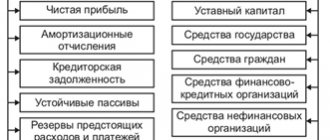As they say, risk is a noble cause, this expression, by the way, fits the description of the venture sector of business more than ever. Investing large sums in innovative projects that cannot give any guarantees about the return of the investment, let alone profit - this is the very essence of the venture business. There are many quite interesting startup ideas that require investment. Many young talents are looking for financial support to bring their ideas to life. At this stage, the venture business in Russia is still underdeveloped. Few people want to pour in hard-earned ideas that seem promising at first glance, but do not provide any guarantees.
What is venture business: terminology
The term venture business is based on the English word “venture”, which is literally translated as enterprise; there is also a second translation – adventure. Combining two literal translations, we get - a risky enterprise, which is an accurate description of this area. Risk investing is popular in the technology and scientific markets.
If you put together a simple definition, it will sound something like this: venture investing is investing in new ideas, projects, and developments. Funding an innovative business idea that could take off in the future and capture a large share of the market.
For business, special methods and programs were invented that calculate and predict the most likely risks, evaluate the idea and its profitability. For an ordinary business, everything is crystal clear, but this cannot be said about a venture business - all the usual rules do not apply here. There is no way to take it and calculate whether the idea of whether it is worth investing money will bring profit. In this case, you can only rely on your own intuition and act according to the situation.
Any innovation is a novelty, a product that is in its infancy; no one can predict what will come of it in the future. There are examples when an innovative idea made its investors fabulously rich, but history also knows many cases of collapse; here it is impossible to know and calculate the result in advance.
Venture business is characterized by the following features:
- Long payback period for initial investments.
- Uniqueness of the idea.
- Innovative nature of developments.
Due to the complex implementation of the idea and the need for scientific research, the payback period is delayed indefinitely. The uniqueness of this area lies in the absence of the same ideas on the market; there are no analogues. And the innovative nature of developments is determined by directions in the field of technology and science.
The largest percentage of such investments falls on the development of technology and communications.
The concept of a venture organization
Venture firms —
temporary organizational structures engaged in the development of scientific ideas and their transformation into new technologies and products and created for the purpose of testing, finalizing the implementation of “risky” innovations before industrial implementation. Modern small venture enterprises are flexible and mobile structures that are distinguished by very high and targeted activity, which is explained primarily by the direct interest of the enterprise’s employees and investors in the speedy successful commercial implementation of the developed idea, technology, object, invention, and with minimal costs.
Venture capital firms operate at the stages of growth and saturation of inventive activity and the still existing, but already declining activity of scientific research. Venture capital firms, as a rule, are not profitable, since they do not organize the production of products, but transfer their developments to other companies - experimenters, patents, and commutators.
Venture capital firms may be subsidiaries of larger firms. The number of employees is small. The functions of an innovation manager are performed either by a traditional manager or by a specialist invited from outside, for example, from a consulting firm.
The creation of venture firms requires the presence of the following components:
1) ideas for innovation - a new product (technology);
2) social need and an entrepreneur who is ready to organize a new company based on the proposed idea;
3) risk capital for financing such firms.
Venture capital financing comes in two main forms - by acquiring shares in new firms or by providing various types of loans, usually with the right to convert into shares.
Venture capital represents the investment of funds not only by large companies, but also by banks, the state, insurance, pension and other funds, in areas with a high degree of risk, in a new expanding business or undergoing dramatic changes.
Unlike other forms of investment, this form has a number of specific features, namely:
1) the investor’s equity participation in the capital of the company in direct or indirect form;
2) provision of funds for a long period of time;
3) the active role of the investor in the management of the financed company.
The following types of venture enterprises are distinguished:
1) the actual risky business;
2) internal risk projects of large corporations.
In turn, the risky business itself is divided into two main types of economic entities. The first type includes independent small innovative firms. The second type are financial institutions that provide capital to the former.
Small innovative firms are founded by scientists, engineers and inventors who strive to realize the achievements of science and technology with the expectation of material gain. The initial capital of such companies is often the personal savings of the founder, but they are usually not enough to implement existing ideas. Therefore, you have to contact one or more specialized financial companies that are ready to provide risk capital for the “promotion” of innovations. In the mid-80s, there were more than 500 such companies in the United States alone.
The specificity of risk entrepreneurship lies primarily in the fact that funds are provided on an irrevocable, interest-free basis; the usual collateral for lending is not required. The resources transferred to the disposal of the venture firm are not subject to withdrawal during the entire term of the agreement. The return of invested funds and the realization of profits occurs when the company's securities enter the open market.
The amount of profit is determined by the difference between the market value of the share of shares of the innovator company owned by the risky investor and the amount of funds invested by him in the project. This share is specified in the concluded contract and can reach up to 80%. Thus, the financial institution becomes a co-owner of the innovating company, and the funds provided become a contribution to the authorized capital of the enterprise, part of the latter’s own funds.
Venture entrepreneurship is also attractive for the Russian economy. The successes of risk entrepreneurship in the development of scientific and technical innovations forced large industrial enterprises of the military-industrial complex of Russia, both in the country and abroad, to undertake internal risk projects or “internal ventures”. They represent a small unit organized for the development and production of new types of high-tech products and endowed with significant autonomy within large corporations. The selection and financing of proposals coming from corporate employees or independent inventors is carried out by specialized services. If the project is approved, the author of the idea heads the internal venture. Such a unit operates with minimal administrative and economic intervention from management.
Within a specified period, the internal venture must develop the innovation and prepare the new product for launch into mass production. As a rule, this happens in the production of a product that is non-traditional for a given company.
The internal risk project also serves to explore new markets. If the project is successful, the division can be reorganized for mass production of this product within the same company, sold to another, or transferred to other divisions.
An intermediate form between purely risky business and internal risky projects is the organization of joint ventures of a new type, representing an association of a small science-intensive firm and a large company. Within the framework of such an association, a small company develops a new product, and a large company provides financial support, provides research equipment, provides sales channels, organizes service and after-sales customer service.
The key incentive for venture capital investments is their high returns if successful.
Firms that specialize in creating new or radical transformations of old market segments are called experimenters. Their job is to promote innovations to the market.
To reduce risk, standard financing schemes are being developed for a certain period. During this period, the explorer must achieve success (if, of course, he is destined to be). For example, financing is for 48 months. Capital investments are divided into five time periods, based on two rules:
1) each new investment is made only if the previous one has justified itself (this means that the developer has made significant progress in creating or commercializing the product);
2) each new investment is larger than the previous one and is carried out on more favorable terms for the investor.
Scientific and technical developments are of priority importance. However, innovative business is by no means an activity of pure science or invention. Often innovative companies are headed by an engineer who is the author of the technical side of the project, and a manager with organizational and commercial experience. The mechanism of such an alliance is formed due to the skeptical attitude of large companies towards risky projects. Having not received the opportunity to implement an innovation in his enterprise, the manager gets carried away with the new idea and leaves his previous place of work. After that, he tries to implement these ideas as an independent entrepreneur.
Venture investor
One of the main characteristics of venture investors is that they are able to take on all possible risks of a future business. All for the sake of obtaining a profit that exceeds the investment hundreds of times.
There is a division of all investors into:
- Business angels/private investors are the largest percentage of all entrepreneurs.
- Venture funds are companies that unite participants into one circle of investors.
- Corporate – entire corporations that finance projects.
Such investors are constantly looking for fresh, promising ideas in which they can invest their money.
TOP largest Russian venture funds
The rating of Russian venture funds by the number of projects they invested per year is available on the website https://ratings.rvc.ru/. List of the largest venture companies in Russia:
| Name | Capitalization | Area of activity | Average share in the project | Average project contribution |
| RVC | about 3 billion dollars | science and technology | 25% | no data |
| Runa Capital | $270 million | commercial ventures at the earliest stages | from 20 to 40% | $3 million |
| e.ventures | $750 million (2013) | innovative research | 10-50% | 0.1-10 million dollars |
| IMI.VC | no data | media sphere | up to 40% | up to 1 million |
| Almaz Capital | $72 million (2013) | innovative research, technology | 10-40% | no data |
| ru-Net Ventures | no data | Internet technologies, offline services, social networks | 30-40% | no data |
| Mangrove | $500 million (2013) | innovative projects from different countries | 20-35% | from 1 million |
More detailed information on each company, as well as a form for applying for partnership and receiving funding can be found on the official websites of venture funds:
- rvc.ru;
- runcapital.vc
- rusve.com;
- softlinevp.com;
- rdif.ru
- iidf.ru and others.
You can also get acquainted with current information about the activities of Russian venture funds, investment activity and trends in the development of the sector on the website of the Russian Association of Venture Investments (RAVI). In total, there are currently almost 200 Russian venture funds with a total capitalization of about $4.5 billion:
Number and volume of operating Russian funds (data from RAVI at the end of the first half of 2020)
Investors have focused their attention in recent years on the following sectors:
- information and communication technologies;
- business solutions;
- medicine;
- innovative building materials, technologies;
- e-commerce.
conclusions
Nassim Taleb, the author of antifragility theory and creator of the Black Swan concept, recommends using a small portion of investments in venture funds in an attempt to catch your lucky swan. But in practice, Russian venture projects, including the announced course on nanotechnology, did not bring any real results. Positive initiatives are hampered by corruption and great pressure on business, especially if it becomes profitable.
The barrier to entry into venture funds is very high. At the same time, in the structure that supports companies in the early stages, all money is subject to incomparably higher risks than in the stock market. And although it is possible to slightly reduce the risk by investing in the later stages of a project with a reliable mechanism for controlling funds, the average investor, in my opinion, should stay away from the venture market, forming his portfolio from liquid and understandable investment instruments with wide diversification.
Venture fund
Such funds imply a specific organization that brings together entrepreneurs who can finance innovative ideas and business plans. Often, it is venture organizations and companies that act as the main elements of such funds - these can be large banks, large corporations, and private investors.
Most adhere to a certain focus in their investments - this could be medicine, technology, communications, oil and gas production. Other businessmen direct their gaze to various areas, looking for promising ideas in various industries.
The object of financial investment is selected following the following criteria:
- Novelty of the idea - developments should only be unique, not previously seen in the world.
- An important point is the possibility of using innovative and patented methods in the invested enterprise.
- The prospect of monopoly status or the likely capture of a large part of the market.
Such funds are headed by a management company, which is responsible for the success of negotiations between private investors and entrepreneurs proposing the idea. Such companies work for a certain percentage of future income.
What is venture investment
For venture investments, these are investments in various startups that are risky and long-term. They are often used for young projects that rely on technology related to the development of applications for gadgets, medicine, or online commerce.
Sometimes they are attracted to existing enterprises in case of complete modernization.
Main differences from conventional direct investments:
- High probability of losing money, no guarantee of a positive result;
- Capital is given more than the “word of honor” to the future entrepreneur;
- Cooperation with inexperienced and newbies in business;
- The first funds are invested in the idea stage.
In conventional strategic investments, the lender prefers to invest in an already profitable and promising enterprise. He worked and tested the business plan, the implementation of the product or service and minimized risks and was well controlled.
The investor’s goal in this case is to receive regular dividends or seize a controlling stake and completely buy out the enterprise.
It is better to explain the principle of the type of venture capital investment with a specific example.
Example. A young entrepreneur has a great business idea, but no funds to implement it. The investor is ready to cooperate and finance innovative developments for the share of another non-existent project. This is a big risk because it is almost impossible to predict success. But, if successful, the borrower can receive huge profits, which are not limited by monetary policy.
Venture investment differs significantly from strategic investment.
Several characteristic features can be identified:
- More often than not, debt capital is provided under a talented and promising team rather than a specific business plan;
- In case of a successful outcome, you can return the invested money no earlier than in 3-5 years. A longer “promotion” stage for scientific startups, which requires a lot of details and special tests;
- The investor initially knows that his share in the new company will be sold. He does not strive for complete control and constantly search for new promising ideas;
- The first few years of profits or dividends are not an issue: no income is spent on further development and expansion. The investor is interested in this and is in no hurry to withdraw their investment until the company begins stable and profitable operation.
In venture investing, there are only two scenarios: either the company will be successful and make a profit from the block transaction more than all costs, or the project will stall and cause harm to health.
In the second case, the investor loses his investment, but not the entrepreneur, who will not be reimbursed by you. This is another important difference from direct investment, where a failed businessman is obliged to repay the loan with high interest on top.
History of the development of investments in innovative ideas
This type of business first emerged in the United States, or more precisely, in the high-tech area - in Silicon Valley. Entrepreneurs were prompted to create venture capital by frequent investments in various projects and the continuous development of science and technology that needed finance.
The trend became relevant in the 80s, when technology, in particular electronics, was developing at breakneck speed. Then the first serious venture companies began to appear, and after a few years there were more than 500 of them.
Various startups are supported in the United States with particular joy; most well-known companies at one time received financial support from investment funds. Small companies engaged in scientific and technical development are most supported.
Development in Russia
The venture business in Russia began its development recently. The impetus for the development of such an area occurred due to an increase in developments in the scientific and technical fields, which required constant investment.
Competition among small businesses in the Russian market is high; companies fight for the right to receive funds for development by showing investors their developments.
Venture Innovation Fund (Fund of Funds)
Target
The creation of a fund to support industry venture funds (Fund of Funds) is aimed at the dynamic development of the venture financing system and increasing the investment attractiveness of venture activities. Venture capital funds are an important financial institution in the field of commercialization. Currently, venture funds in Russia have not received sufficient development. Part of the reason is that the state does not take on real risks, and there are also no strong incentives for investing in high-risk projects in conditions where it is much safer to invest in the primary industries.
It is assumed that the Fund of Funds participates on an equity basis in the capital of the created industry venture funds.
Experience and scale of application
The Venture Innovation Fund (VIF), the purpose of which is to form the organizational structure of the system of venture investment in innovative projects, was formed by order of the Government of the Russian Federation dated March 10, 2000, No. 362-r, as part of the implementation of the “Main directions for the development of extra-budgetary financing of high-risk projects ( venture investment system) in the scientific and technical sphere for 2000-2005", approved by the Government Commission on Scientific and Innovation Policy on December 27, 1999,
VIF was registered in St. Petersburg in July 2000 with a fixed capital of 200 million rubles as a non-profit organization in the form of a “fund” with state participation. The first tranche in the amount of 50 million rubles from the Russian Fund for Technological Development (RFTD) arrived at the VIF settlement account in August 2000.
To date, VIF is the first real Russian “fund of funds”, which is designed to participate in building a system of venture investment and investment institutions with Russian and foreign capital investing in technological innovative businesses.
VIF organizes its activities by participating in the creation of industry venture funds on a competitive basis, the share of investments in each of which should not exceed 10%. The volume of funds managed by each of the created funds must be at least three million US dollars.
However, due to insufficient government funding (in fact, only 50 million rubles from the Russian Technological Development Fund were allocated to the fund), VIF took part in the creation of only one venture fund - the “Innovative Venture Fund for the Aerospace and Defense Industry” (St. Petersburg) with a share of 30 million rubles.
The legislative framework
Many regulatory issues regarding the activities of the established Venture Innovation Fund have not been resolved.
In general, there is no developed legislative framework for venture financing.
Features of the approach
Direct government participation in the formation of the Fund of Funds and the implementation of the scheme for its participation in the capital of industry venture funds presupposes the federal government’s trust in private investors and regional authorities (if they participate in financing). At the same time, experts note that with a high level of corruption, an opportunistic model of behavior of private business and the transfer of the right to make strategic decisions to this sector, the effectiveness of this scheme may be limited.
At the same time, at the present stage it is important to compensate for the high risks associated with the activities of venture funds, to a certain extent to involve the state in actively solving legislative problems of the development of venture financing, therefore the direct participation of the state in the creation of the Fund of Funds seems justified.
The Fund of Funds concept assumes that:
support for the creation of industry venture funds is carried out on a share basis;
State participation in the capital of the sectoral fund is gradually decreasing.
It is usually expected that support from the Fund of Funds should be provided on commercial terms, but at the initial stage it is important to quickly start the process of establishing sectoral funds and for this reason support can be provided in the first years on a grant basis.
To ensure the liquidity of venture investments, a network of exchange platforms should be created to sell shares of high-tech companies.
Support object
Industry venture funds.
Main positive effects
The fund of funds is considered as a tool for stimulating the creation and development of venture funds and attracting extra-budgetary resources for their activities.
The main indicators are the volume of assets of venture funds, the number of innovative firms that received support, the share of venture financing in the volume of financial resources of innovative firms, the share of venture investments in the high-tech sector in the total volume of direct investments, the share of successful projects, an increase in the level of extra-budgetary co-financing of venture funds.
Necessary costs
To further develop the activities of the VIF, it is necessary to increase its authorized capital. Moreover, it is advisable to carry out such an increase not with one-time financial participation of the state, but through the creation of an effective economic mechanism for using budget funds, which involves, among other things, direct financial returns for the federal budget.
According to calculations, the total minimum required size of an industry venture fund for investing in early-stage companies should be at least 450 million rubles.
Based on the fact that at least ten venture funds must be represented in the portfolio of an institutional investor (Fund of Funds), and also bearing in mind that the share of VIF participation in venture funds will average about 30%, it is necessary to determine the minimum allowable amount of the Fund's fixed capital at the level of 1.35 billion rubles.
Target indicators for the use of the tool
It is planned to create approximately 10 industry venture funds.[27]
The total financial effect of the Fund's budget investments with a minimum fixed capital of 1.35 billion rubles. will amount to at least 3.7 billion rubles over five years.
Over an investment period of five years, venture funds created with the participation of VIF will create up to 4 thousand jobs.
A demonstration effect will be ensured - attracting large Russian companies and foreign investors to the creation and financing of venture funds.
Main stages of using the tool
Adoption of the necessary regulatory legal acts to ensure the effective operation of the Fund of Funds - 2006.
Investments from the federal budget into the capital of the Fund of Funds - 2006.
Investments from the federal budget on an equity basis in industry venture funds - since 2006.
Investments of industry funds in venture firms - since 2007
Gradual reduction of state participation in the capital of industry venture funds - since 2008.
A network of exchange platforms for trading shares of high-tech companies - since 2011.
The first exit from the capital of venture capital firms was 2012-2013.
How does a company develop with a venture?
Each small company applying for financial assistance from an investor goes through the main stages of development:
- Sowing - there is a promising idea, but its implementation requires investments. Test material and products are created, and then investment in the project occurs.
- Startup - test products have already been created at this point and are undergoing all kinds of research and testing.
- Early stage - the product has passed all tests, the problems that arose have been eliminated. Preparation for future mass production and market entry.
- Expansion – advertising the product and starting sales of the finished product.
- Late stage - the moment of global expansion of the company comes, income growth, opening of a large and recognizable production facility.
Peculiarities
A feature of a venture enterprise is long-term investment. Profits from investments can be received after two to five years. During this time, the company goes through three phases of formation:
- pre-launch with pre-sowing, sowing stages, prototype creation stage;
- starting with early or late stages of launch;
- development with stages of early growth, expansion, pre-final stage and exit.
After the development phase, if the released product is successful and increased demand is generated, due to the need for new capital investments, either the enterprise is sold or it is registered on the stock exchange with the subsequent issue of shares.
After creating a prototype and testing it on the market, the venture enterprise becomes attractive to large holdings that invest in venture shares in order to restructure its activities.
There are internal (independent) and external ventures. The organization of the former is carried out by the authors of the idea, the latter - with the involvement of funds from state/non-state funds, contributions from legal entities/individuals, and grants. Investments in an enterprise are carried out in several stages; venture capital investment cycles range from 12 to 18 months.
It is difficult to evaluate the effectiveness of an investment in a venture using key economic indicators - the main benchmarks are: customer acquisition cost, life cycle value and group analysis.
Attractive areas for investment activity in Russia in 2020 were the telecommunications sector (financing amounted to $83 million), computer technology (it was possible to attract $14 million) and medicine (invested $12 million).
Well-known examples of successful ventures include Apple, YouTube, Google, and Intel. In Russia, in 2009, the “Innovative Russia-2020” project began to be developed, which involves increasing the share of venture enterprises to 40 - 50%.
How does venture investment work?
No investment begins simply with a request for money and a positive response. Before starting financing, future investors examine the following factors:
- The first step is to search for all projects that require investment.
- After collecting projects, the analysis phase begins - companies are selected and eliminated.
- A business plan for work is discussed and drawn up with selected enterprises.
- An investment strategy is formed - each investment step is described.
- An agreement is signed between the two parties.
- To successfully promote the project, the investor provides not only financial assistance, but also business connections, transfers his own experience, and helps with experienced personnel.
- At the end of the cycle, the investor receives back the invested capital and profit by selling a stake in the developed company.
Pros and cons of venture investing
For beginning entrepreneurs, this type of capital sometimes becomes the only way to open their own business.
The Russian venture capital market has been actively developing only since 2000, but has already led to many successful business projects. An inexperienced businessman gives a certain part of the future business, but this is better than giving up the idea altogether.
What benefits are there for an investor who does not receive any guarantees and may suffer large financial losses?
Among the obvious advantages of this type of investment:
- Maximum and unlimited profits with successful promotion of a business project. There are many real examples where the return amount exceeds the investment by 1000% over several years;
- For “promotion” of the project, often in small quantities. Obtaining a bank loan for young and inexperienced entrepreneurs is an unrealistic problem in domestic business practice. Venture investors prefer to invest money in interesting projects that have no visible prospects, without requiring 100% guarantees and collateral;
- Working with each new case brings a special experience, helping the investor grow as a businessman. You are developing your financial sense and have formed your investment portfolio. In addition, venture capital investments are attracting increasing attention from government agencies and encouraging them, thus adding a certain fame and respectability to business angels.
The entrepreneur receives real money for development, which does not apply to huge loan interest. He does not return the property in case of refusal, I feel more freedom for self-expression. In the investor's shares, his knowledge, relationships and tries to conduct the project in a cost-effective manner. We can say that the first is intelligence and the second is the availability of finance.
Almost the only drawback of this type of financing is that the risk of complete loss of investment is too high. Most modern projects are related to virtual reality and the Internet, so it is simply unrealistic to calculate profits. According to statistics, only 10-20% of the total number of funded projects are successful.
What venture funds exist in Russia?
The list below tells about the largest funds in the Russian Federation; in addition to them, there are also small enterprises that invest money in the development of promising ideas.
The largest companies are:
- Runa Capital is a fund that promotes electronics, Internet resources and promising startups (Rolsen, LinguaLeo).
- Ru-Net Ventures is a fund that prefers the ideas of Russian minds. Thanks to him, the world saw Yandex.service, Delivery Club, Ozone.
- VC – they prefer to invest in games, media, programs and applications for PCs and smartphones.
- Kite Ventures - they give preference to business-to-business work; the main difference between this fund is its low interest rates.
- ABRT is also a business-to-business operation, preferring to invest at an interest rate of one to three.
- ventures is a German venture fund that is actively developing enterprises in Russia. They approach investing cautiously, but invest a lot of money.
All of the funds listed keep their reputation at the same level, tested by time and real companies. Projects developed thanks to their help are becoming popular not only in Russia.
How can a private investor enter into a venture deal: methods, description, links
In this article I tell you how a private investor can invest in a startup. There are four options: a venture fund, a syndicate of business angels, a venture club, a crowdfunding platform. After reading the article, you will understand the features of each method, get a starting point and be able to act independently.
But first, a disclaimer: venture capital investments are dangerous for your finances. Therefore, consult with your wife/colleagues/psychotherapist whether you need it. Then grab a Jack Daniels and think again. If after this your decision does not change, then take responsibility and begin your venture journey.
Method No. 1. Invest through a venture fund
This is the classic way: we give capital to a venture fund one time. The fund then combines it with the capital of other investors and invests the money in a portfolio of projects. After ten years, the fund is closed, and the profits received are distributed among the participants.
In this case, the usual structure of a venture fund looks like this:
Limited Partners are investors who provide the fund with money. General Partners are the fund's managers who provide management. The portfolio of projects is collected depending on the specifics of the fund: these can be projects of a certain stage or a certain field of activity. Often all together.
Advantages
1. Investing in a fund does not require knowledge or time. It is enough to put the capital under management.
2. The fund's investment decisions are usually better than those of private investors.
3. The fund diversifies investments and reduces risks.
4. The fund is the safest way of venture investment.
Flaws
1. Investors do not control the fund's decisions.
2. The minimum investment amount is $500,000.
3. High commissions: 5-10% upfront fee and 10-20% success fee.
Do the advantages outweigh the disadvantages? I think that yes, they outweigh.
How to invest
The global algorithm is simple: find a fund, contact the manager, follow the instructions. Next will be the KYC procedure and direct onboarding. Sometimes onboarding takes up to a couple of months, but that’s how fund processing works.
A list of domestic venture funds can be found here. A list of well-known global venture funds can be found here. You can find out what to look for when choosing a fund by subscribing to my channel and waiting for an article on this topic.
Method No. 2. Invest through a syndicate of investors
If investing in a fund is boring and you want to steer a little, then join an investor syndicate. A syndicate is a group of business angels who invest together. As a rule, syndicates are not formalized legally, but exist in the form of informal communities. Each project in the syndicate is analyzed individually, and you can invest in it at will. If there is no desire, then you can skip the project and wait for the next one.
Teamwork of the syndicate allows you to share expertise, consolidate capital and distribute risks between participants. The syndicate also reduces individual costs for lawyers and due diligence.
Advantages
1. The investor independently decides which project to invest in.
2. The minimum investment in the project is $20k.
3. You can find your own project and offer it to the syndicate.
4. Syndicate commissions are lower than funds. Sometimes they are missing.
5. The syndicate provides good networking, which helps the main business.
6. Participating in a syndicate is interesting.
Flaws
1. The syndicate’s projects are at the seed stage and have an increased risk.
2. Compared to the fund, the syndicate’s incoming project pipeline is narrower, and the quality of the projects is lower.
3. You need to be able to evaluate projects. This requires knowledge, experience and intuition.
4. Investors are geographically tied to the syndicate.
Do the advantages outweigh the disadvantages? Depends on the specific syndicate.
How to invest
Choose a syndicate, go to the nearest event, look at the projects and choose the right one. Then act according to the circumstances.
Active investment syndicates in Russia: United Investors, Uzkiy Krug.
Method number 3. Join the investment club at a venture fund
An investment club at a venture fund is a cross between a syndicate of business angels and a venture fund. That is, organizationally the club works like a syndicate. But there is an important difference: projects are brought to the club by a venture fund, not private investors. In addition, the fund acts as the lead investor in the transaction and with its own money confirms its faith in the project.
Advantages
1. The quality of projects remains high.
2. The investor independently decides which project to invest in.
3. The minimum investment in the project is $25k.
4. Project stages are not limited to the seed round.
5. You can discuss projects with a venture fund and other club members.
6. There is no geographical reference, since the projects are selected by the fund.
Flaws
1. Club commissions are identical to fund commissions.
2. Due to the complex organizational structure, transactions are delayed. Do the advantages outweigh the disadvantages? Definitely.
How to invest
I know of two venture clubs in Russia: Alta Club based on Altair Capital and Starta Capital Fund II based on Starta Ventures. Contacts of companies are on the websites. The hit scheme is old: write to the manager, start onboarding.
Method number 4. Invest through crowdfunding platform
We are not talking about Kickstarter, but about its investment analogues. For example, Wefunder or SeedInvest. These platforms connect projects with investors, provide a legal structure and automate the transaction process.
In general, a crowdfunding platform is similar to a large-scale syndicate of business angels. You can invest from anywhere in the world; the geography of projects is also wide. At the same time, crowdfunding sites check projects and weed out scammers. Although in practice this does not work everywhere, and fraudulent projects do occur.
Advantages
1. The investor independently decides which project to invest in.
2. The minimum investment in the project is $1,000.
3. Large selection of projects.
4. There are no intermediaries, except for the crowdfunding platform.
5. The investment process is simple and similar to shopping in an online store.
Flaws
1. Projects are at the seed stage.
2. It is impossible to adequately evaluate the project team.
3. Ninety-nine projects out of a hundred fail.
4. Possible fraud.
Do the advantages outweigh the disadvantages? In most cases no. On some platforms yes.
How to invest
Register on the platform, select a project, click the “Invest” button. Next, enter your card details, send money, and receive company shares to your internal account.
Popular equity crowdfunding platforms: Wefunder, SeedInvest, AngelList, FundersClub.
My recommendations: AngelList and FundersClub. Processing on sites is more complicated, projects appear less often, but their quality is higher. Thus, the first platform allows startups that have been invested in by professional venture capitalists. The second brings startups from the Y Combinator accelerator. These are good filters that increase the likelihood of success.
PS I made a website where I publish interesting articles of my own. Including about investments. Come visit.
PPS I also launched a telegram channel for those who are more familiar with instant messengers. In addition to articles, I publish small posts on various topics on the channel. I'm also looking forward to your visit.
How does a venture fund differ from a traditional one?
The established laws and regulations of traditional funds are fundamentally inconsistent with the characteristics of venture capital funds.
The main differences between the funds:
- Startup support mindset. Traditional funds invest in management and various corporations, their structures, all investments go through the system from management to employees, which takes time. All innovations and fresh ideas are limited by the old school system. Innovative investors find promising startups and communicate directly with developers.
- Predictability of investments. Traditional investors invest money starting with a forecast of future profits and an assessment of risks. But in the case of a venture, it’s the other way around – we’ll predict the unpredictable, invest intuitively, and look to the very end.
- Financial information. In the first option, all the detailed information collected by employees exists; the venture must be content with the bits that it has.
- Ability to quickly change strategy. Traditional funds are horrified by attempts to change the allocation of allocated money, changing strategy in the process. Venture capitalists, on the contrary, are trying to achieve maximum dynamics so that they can change the strategy at any time, redistribute the budget and take a more advantageous position.
- Different investment cycles. The first ones invest in the same company for many years. The latter invest for a maximum of 18 months and always try to move the idea to the next cycle faster.
- Different approaches to management. Traditional funds try to control every process and have as much power in the company as possible. The venture loosens its grip and manages only what it considers necessary, leaving the rest to the company itself.
- Views on competition and cooperation. In the first case, there is a war for the right to invest, no agreements, only victory. In innovative investments they are not afraid of competition; they prefer to work together, developing the project.
Scheme of work
A simplified workflow looks like this:
- The project initiator submits an application for funding.
- Specialists conduct a comprehensive analysis.
- Participants contribute money to the fund in cash or “commitments.”
- The management company contributes its share of funds.
- A legal and organizational framework is provided for the project.
- Consistent funding is allocated at different stages of the project. Please note that funds have the right to issue shares of the financed company.
- The Foundation monitors the progress of the project and provides support (3–10 years).
- At the end of the cycle, the project is exited by selling shares or shares: on the stock market, to a strategic investor, to a financial investor, to the management of the facility.
Rule 2. A venture fund always exits (unlike strategic corporate and individual investors). It is important to accurately determine the moment of exit, when the further growth rate of capital value will slow down and will not bring excess income (see Rule 1).
Useful video: how venture funds work.
Prospects for development in Russia
Listening to the opinions of fund owners in this area, one can understand that the venture business is a niche that is currently developing. A business has all the factors that influence its prospects. Newbies in the business face various problems that are solved with the help of accumulated experience, knowledge and managers with experience.
There is no single legal framework for venture, which means that the business will not receive support at the state level. This is the main problem in development, but besides this, there are several other limiting factors:
- Lack of information.
- There are no qualified employees; everything needs to be trained.
- Registering a venture fund is complicated and takes a lot of effort and time.
When these factors are eliminated and government services are provided. assistance, the venture business in Russia will begin to develop at breakneck speed.
The largest venture funds in Russia and the world
To give you an idea of the scale, we will give examples from international practice. Approximately 1,300 US venture funds have more than $200 billion under management.
In 2020, US funds invested more than $40 billion in venture projects (the situation with exits is somewhat worse - there were only 31 IPO transactions).
The venture market is well developed in Europe (10% of total investments are venture capital), China, India, Brazil and other countries.
The world's largest venture funds: Accel Partners, Softbank, Index Ventures, Sequoia Capital, Kleiner Perkins Caufield & Byers.
There are 178 venture funds registered in Russia with a capital of $3.8 billion, but about 60 of them are actively operating. The volume of investments in 2020, even according to the most optimistic estimates, did not exceed $0.5 billion. The average check is less than $1 million.
Table 2. TOP of the most active Russian non-seed venture funds in 2020 (according to firrma.ru, million dollars).
| Organization | Number of projects | Number of outputs | Investments 2016 | Asset portfolio | Average bill |
| Target Global | 21 | 8 | 90 | 300 | 0,2-30 |
| Flint Capital | 18 | 1 | 21 | 100 | 1-1,5 |
| Runa Capital | 12 | 2 | 20 | 270 | 3 |
| Almaz Capital | 10 | 3 | 20 | 250 | 3-5 |
| 12 BF Global Ventures | 9 | 3 | 10 | 400 | 1 |
| Maxfield Capital | 8 | 4 | 3 | 100 | 1,5 |
Note. The rating did not include: foreign organizations, seed funds, companies with a lifespan of less than 1 year. Some recognized popular large funds (Prostor, ITech) also did not make it into the TOP, which is due to two factors:
- reorganization - transition to the passive phase of operation and launch of subsidiary funds;
- increasing orientation towards the global market.
Among the foreign funds investing in the Russian economy are:
- Numa Invest (6 projects);
- Enterprise Ireland (5 projects);
- Y Combinator (4 projects);
- 500 Startups (3 projects);
- Vostok New Ventures (2 projects).
Table 3. TOP of the most active Russian seed venture funds in 2020 (according to firrma.ru, million dollars).
| Organization | Number of projects | Number of outputs | Investments 2016 | Asset portfolio | Average bill |
| IIDF | 91 | 3 | 19 | 92 | 0,03 — 5 |
| Altair Capital | 24 | 2 | 10 | 50 | 0,3 |
| Pulsar VC | 18 | 0 | 1 | 10 | 0,125 |
| Starta Capital | 15 | 0 | 2 | — | 0,15 |
| The Untitled Ventures | 12 | 0 | 1 | — | 0,8 |
| Run Capital | 10 | 0 | 10 | 30 | 0,8 |
| Moscow Seed Fund | 7 | 6 | 1 | 9,2 | 0,9 |
Since 2013, the main part of the seed market has been occupied by the Russian venture fund for the development of Internet initiatives.
Finally, the TOP “newcomers” entering the market in 2020 are as follows:
- Admitad Invest (7 projects);
- Sistema VC (4 projects);
- CommIT Capital (3 projects);
- Sistema Asia Fund (2 projects).
How to start a business?
Before you start developing a business plan, you need to ask questions - what is a venture business, how does it function, what knowledge is required. Having understood the essence, you can begin to prepare all stages of the business plan. The first impressions of investors and the future positive response will depend on it.
The requirements put forward by investors are both simple and complex - honesty in the work of the management company and experienced managers.
They have the greatest influence on:
- A well-written business plan.
- Close-knit, experienced, hardworking staff.
- Intellectual Property Rights.
- Selected managers.
Start-up investments
The total capital of a venture fund is usually $5,000,000-10,000,000, investments in each project do not exceed $5,000,000.
All members of the joint-stock company invest from $750,000 in the general fund project. Such companies operate, on average, for 10 years, after which the shares are sold, the invested money and net profit are divided among members of the company.
Income comes not only from the end of the fund’s activities, but also from various bonuses. When exiting the transaction, the profit received ranges from 20 to 40% of the total investment.
Innovative venture business is gaining momentum in its development, which until recently was a foreign sphere, is becoming increasingly relevant in Russia. Such investments help speed up the implementation of an innovative idea. But efforts in this matter must be made by both parties to the contract.
The enterprise receives material and other support, launches production and releases a product, and the venture capital company directs its efforts to increasing the company's capital. Many well-known companies have received help from venture capital, for example, Microsoft and Intel. It is important to always remember that venture is a constant risk. You need to treat it responsibly, consider the proposed ideas, try to look into the future and understand whether the new product will occupy the market or whether the business is not worth the investment.
LIKBEZ: HOW VENTURE FUNDS MAKE EARNINGS
Venture capital is capital provided by investors for various companies. As a rule, investments are made at the very first stage of the organization’s formation, and this stage is considered promising, but high-risk, since no one knows whether the product will be successful or will remain unnoticed in the market.
Investment capital is usually attracted by startups. Such companies have no collateral for loans, they have no history, and the only option for them to raise funds is a venture. Also, either an ICO or crowdfunding can be an alternative. ICO is usually used to invest in projects based on blockchain technology. Such startups also have risks, and quite large ones at that.
By investing money, a venture investor usually receives his share of a young company. His goal is not to remain as investors and owners for many years, but to sell his share as profitably as possible, choosing the right moment for this.
The best option for a venture investor is for the organization to go public. Also, as an option, you can sell your part at a cost that will exceed the original one.
It is important to understand that venture capital is illiquid, so an investor takes a lot of risk when investing in this area. You will have to wait a long time for a return of funds, 5 years or more, but if you make the right choice, your income will be significant, which is why many choose high-risk assets.
Structure of venture funds
As a rule, funds are created as LLCs, which always have a manager, as well as investors who have invested their money in the fund. The general partner of the company manages its activities, while passive partners do not take part in management, but can influence management through the board of directors.
The general partner also bears risks, like venture investors, since he can invest up to 5% of the total investment in the fund with his own funds.
The general partner also receives a management fee; in the largest funds, he can receive 3% of profits per year for his activities, but, as a rule, this fee is 2%.
The second remuneration that the general partner receives is 20% of the fund’s profits, but the money can be disposed of only after the funds have been returned to all venture investors.
Venture fund: life cycles
A venture investor invests in a fund in stages, that is, funds are received in parts, taking into account the investor’s share. Before sending funds, the venture investor receives from the general notification what they will be used for at a specific point in time, and only after that the money transaction is carried out.
The maximum lifespan of a fund is 10 years, but in reality funds exist for less time, as a rule, a period of up to 7 years. Everything depends on the activities of the fund itself, and on the stages at which it is at a particular point in time.
Evergreen funds deserve special attention, they have existed for decades, but they attract investments for other projects.
The main task of the general director is to search for investment projects that would generate a profit 10 times greater than the amount of funds invested in them.
As statistics show, 3 or 4 startups out of 10 fail, the same number bring in little income, and only a couple out of 10 bring in big profits.
The average return rate is 2.5 out of 3, which is considered a good result.
Annual return is another quantitative characteristic of venture funds, and it normally amounts to 25% per year. There are also very successful projects when the profitability was up to 900% per annum, but such cases are rare.
Venture investing: stages
Pre-seed is the first stage of investment, but at this stage there are usually no investors. All investments begin to flow at the series seed stage. This is the stage when the product begins to be released onto the market, and this is the stage when sales are just beginning.
The average investment size for the fund can reach 2.5 billion.
At the stage of active sales, investment can reach $13 million, but this is a high-risk stage, and here the earning potential for a venture investor is truly great.
There are also stages B, C, D - this is the stage of scaling the business and its entry into an IPO. Here the return on investment will be less, but the risks here, by the way, are also minimal.
Raising funds for projects
In order to find worthy investors, fund owners build a network of contacts. A lot of specialized events are held, as well as various events to which potential partners are invited. Meetings at events are scheduled down to the minute, and they last no more than 15 minutes, since there are a lot of people who want to successfully invest.
Venture capitalists actively share contacts and projects, and information on the work of funds is provided. At meetings, other projects that are worth investing in may be recommended.
Most funds on the market are pass-through funds, since their prospects are quite small. Many of the funds end up on blacklists, and this puts a kind of bad mark on the fund, and it will become illiquid. Therefore, you need to carefully check the information on the fund so as not to become a partner in an illiquid project.
Personal communication can add a positive reputation to the fund and get support for the project. Often business partners help each other with paperwork, especially if the venture investor lives in another country.
Close personal relationships between partners of venture funds usually develop in Asia. In China or India it is simply impossible to work if you don’t know your partner’s family and don’t go to visit them.
Networking: prospects and challenges
The more active the network, the better its reputation in the business sphere, and therefore the higher the percentage of passive offers from potential investors from different countries.
A company can get financing through an investor they know, and the project they like in this case will not require in-depth analysis, since the venture investor can get advice from people in the network.
The ability to obtain advisory support is one of the advantages of a developed network of contacts. As a rule, a response to a project you like can be received within 2 days. This approach minimizes risks for all fund partners.
What actions of the venture fund after the conclusion of the Agreement
Venture investors are unofficially divided into two groups - passive investors, that is, those who helped with money, but do not interfere with the work of the organization, and active investors - those who participate in its operational work. If this fund is a leader, then the investor can take part in the board of directors.
Even passive investors receive monthly or quarterly reports on how the corporation's portfolio or operating performance is shaping up. After monitoring the situation, goals and objectives are determined to help the fund develop and establish itself in the market so that it enters the IPO.
Recruiting can help, as well as developing relationships with potential clients, as well as developing a crisis management base.
As a rule, well-known funds have a long list of useful contacts for each vertical. Typically, company directors themselves decide which investor to accept the fund, but this happens if the CEO has more than 50% of the shares.
In order to attract truly large investments, a pool of relevant investors is collected, which consists of dozens of contacts. Each investor receives an intro, since options with classic presentations are not considered here.
Founders are not provided with such information, since they will not have enough time to study the documentation.
How do you get out of investments?
The most important aspect of investing in venture capital funds is how you exit the investment. For this purpose, a whole system of recommendations has been developed among participants in a certain network.
You need to be familiar not only with investors, but also with managers, as well as advisors who work in different directions. You need to have a network of contacts, it’s difficult to just find an organization on the Internet, write a letter, and immediately launch an IPO. In a networking environment, personal meetings and business lunches are welcome, and this is the only way to make valuable acquaintances.
Building useful contacts is the foundation’s superpower. Networking brings success at every stage and ensures successful exit from the fund.
Finding a fund with a positive reputation is a successful path for a venture investor.
Vasily Alexandrovich.










